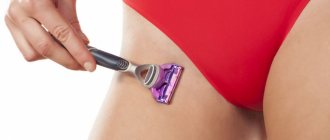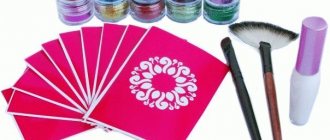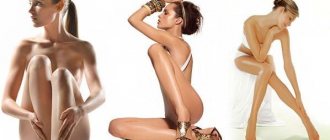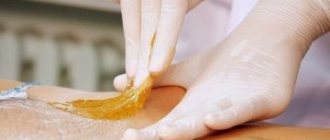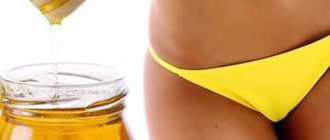Ingrown groin hairs occur when hairs removed with a razor, wax, or tweezers continue to grow under the skin.
When ingrown hairs appear in the groin area, you may notice round papules (red bumps that look like a rash), pus-filled bumps, or pustules on the skin. In some cases, the skin around the ingrown hair may darken (hyperpigmentation).
You may also feel pain or itching around the hair. Ingrown pubic hair occurs on the inner thighs, labia and vagina in women, or on the scrotum and penis in men.
Signs of ingrown hairs
Symptoms of improperly growing rods appear 1-3 days after the cosmetic procedure.
Signs of ingrown hairs in the bikini area:
- growth points began to look like pimples, ulcers, bumps, bruises;
- the epilation site is swollen, red or painful;
- inflammation appeared in the bikini area;
- the skin itches or burns after treatment;
- curled hairs or dark spots are visible in the area of discomfort.
Such symptoms cannot be ignored, otherwise the problem of ingrown hair in the bikini area will have to be addressed in the hospital.
After unsuccessful hair removal, it is difficult to avoid the formation of papules (round dense balls) and purulent pimples (pustules). You can get a deformed hair from them.
Symptoms
Diagnosing an ingrown toenail is usually not difficult. The main symptom is pain in the area of the periungual fold, first with pressure, and then at rest. Swelling and redness quickly develop. Pus soon begins to appear between the roller and the nail. Redness increases, and with the use of various remedies it may temporarily decrease, but almost always the process becomes chronic and can last for months. Chronicity of the disease is characterized by the appearance of hypergranulations (“wild meat”). In very rare and advanced cases, inflammation can spread to the phalanx bone - osteomyelitis.
There are usually no changes in the patient's general condition. In a blood test, there may be a slight increase in the number of leukocytes during acute inflammation and an increase in ESR. With prolonged ingrowth, it is necessary to perform an x-ray of the finger to exclude involvement of the phalanx bone in the process - osteomyelitis.
Features of the bikini area
The intimate area is different from other areas where vegetation is removed.
- the hair is very coarse, especially if the lady is naturally dark or red-haired;
- the skin in the bikini area is thin, blood vessels pass close to the surface, and immediately begins to become inflamed;
- high sensitivity in the area between the legs;
- uneven surface for cosmetic procedures;
- constant contact with clothing;
- special, triangular hair structure.
Ingrown hairs are new hair shafts that, as a result of damage to the hair follicle, begin to grow not in the natural direction, but down or to the side. They need to be pulled out from under the skin. Through micro-wounds and cracks in places of growth, microorganisms enter the body, causing pathological processes. All this provokes an inflammatory process that can lead to ulcers, bumps, scars, scars and dark spots.
When epilating, a woman plans to remove hair along with the hair follicles. If something goes wrong, only the shaft and part of the follicle are torn off. As a result of mechanical damage, the position of the hair root changes, and soon a weakened hair appears, which grows not in the intended direction, but in the direction where the bulb has deviated, even growing inside the body. And those rods that do reach the skin, due to thinning, cannot penetrate the epidermis and grow under it, causing inflammation.
What is an ingrown toenail?
With this disease, the nail plate grows into the periungual fold. The big toe is most often affected. The disease begins with some “provoking” moment - an injury during a pedicure, a bruise, wearing tight shoes, etc. Swelling of the roller occurs, it is pressed more tightly against the nail plate and is slightly injured by it (an abrasion, a microcrack occurs). This, in turn, causes increased swelling and pain. Almost immediately an infection sets in - microorganisms invade the wound. Inflammatory phenomena gradually progress - redness appears in the area of the periungual fold, pain and swelling increase. Pus begins to secrete between the nail and the roller, and later hypergranulations appear there (the so-called “wild meat”). Before infection sets in, ingrown toenails can still be stopped by treatment at home - it will be described below. When suppuration occurs, and especially when “wild meat” appears, conservative treatment is always ineffective; it can only bring a short-term reduction in symptoms. Only surgical intervention can radically help.
How to cure the effects of hair removal or ways to combat it
To prevent the possibility of an ingrown hair follicle and prevent inflammation, several skin care methods are suitable.
How to remove ingrown hairs in the bikini area, removal methods:
- scrub the skin;
- soften the skin daily with a moisturizer;
- take steaming baths;
- refuse synthetic underwear.
If you prepare in advance for hair removal and grow hairs of sufficient length, this will relieve discomfort and further unpleasant consequences.
If large bumps or ulcers appear, then you need to seek medical help. You cannot remove pus yourself. Skin diseases can only be cured by a dermatologist or surgeon.
How to prevent hair growth?
Ingrown hairs are more common during pregnancy or menstruation, when certain sex hormones are released more. At this time, intimate hygiene is especially important.
When it comes to removing unwanted hair, there are a few things to keep in mind:
- Do not pull the skin upward while shaving. This tightens the skin and makes shaving easier, but can also cause hair to re-grow.
- When shaving, always use a new, sharp razor.
- Remove hair in the direction in which it grows, and before doing this, be sure to rinse the shaving area with warm water.
- Never shave without shaving gels and other creams that make the skin soft and make the whole process easier.
- Cleanse your skin with salicylic or glycolic acid. These substances will help keep hair follicles open to prevent hair from growing into the skin. Do not use these products if you already have ingrown hairs, as they may further irritate the damaged area.
- Use benzoyl peroxide gel. It can be bought at a pharmacy. It can dry out the affected area and reduce redness around ingrown hairs. Moisturizing your skin also helps remove dead skin cells that clog hair follicles.
- Sugar is a natural exfoliant. Mix it with olive oil or honey to moisturize your skin and kill bacteria on your skin. Apply the mixture in circular motions, then rinse with warm water.
- Baking soda helps remove dead skin cells and reduce inflammation. Mix one tablespoon of baking soda with one glass of water. Apply to skin with a cotton swab and rinse with cold water.
- Tea tree oil destroys bacteria and reduces swelling. It is sometimes used to treat acne, but you can also use it in this case. Mix the oil with water to dilute it and apply to skin with a cotton swab.
Scrub for ingrown hairs
To better remove follicles, you should treat your body with a fine-grained scrub before going to a cosmetologist. This will help combat the negative consequences of hair removal. The scrubs are simple and easy to use, after which you simply remove the crooked hairs.
Before peeling, steam the skin for 10 minutes by taking a hot bath or applying a damp hot cloth to the removal area. The water can be simply clean, or you can take herbal decoctions.
If there are purulent areas, the scrub cannot be used! You also cannot remove or squeeze out the pus yourself. This will only spread the pathological process over a larger area. This problem should be treated by a dermatologist.
Use pure medicinal herbs or mixtures thereof. Chamomile, celandine, sage, calendula 1 tbsp each. for 0.5 liters of boiling water. Simmer the mixture over medium heat for a quarter of an hour. Leave to cool to 60°C, remove the sediment and wet the fabric for a steaming compress for the bikini area. The heat prevents further damage to the delicate bikini area.
Apply the abrasive mixture to the prepared area and rub the skin with gentle finger movements. Scrub particles remove the microscopic layer of cells, making it softer and thinner; even weakened hairs will be able to break through the treated epidermis. All you have to do is remove the ingrown hair in the bikini area with tweezers. After scrubbing, the body needs to be moisturized by applying cream or cream.
Folk recipes
Many women prefer to use natural products after hair removal.
Photo: to prevent the appearance of a rash after hair removal, you can wipe the skin with herbal decoctions
They relieve irritation well and are suitable even for sensitive skin, for example on the pubic area:
- the most effective remedy is a compress made from aloe pulp;
- lotions and rubbing the skin with decoctions of medicinal herbs are very helpful: chamomile, calendula, string;
- for ingrown hairs, baths with medicinal herbs help to steam the skin and painlessly remove such hairs.
Homemade scrub recipes
To combat the consequences of unsuccessful hair removal, ready-made store-bought or homemade products are suitable. Making a remedy for ingrown pubic hair in the bikini area is easy. Granulated sugar, extra salt, the remains of ground coffee after brewing, finely ground bran, badyagu, grain flakes, and ground medicinal herbs are used as an abrasive. Mix the abrasive component with the viscous base 1:1. The basis is shower gel, cosmetic cream, liquid cream, skin oil.
Such homemade scrubs will help bring the skin back to normal, as in addition to the exfoliating effect, they have a moisturizing, nourishing and anti-inflammatory effect. And herbs will complement the treatment. If you add 1 tsp to the scrub. baking soda, the product is suitable for thick and hard skin. After this, the deformed hairs can only be pulled out with a pin or needle.
Coffee-coconut scrub
This product contains coconut oil, ground coffee, coconut flakes, granulated sugar, and extra salt. Heat the oil until viscous in a water bath. Add the necessary components 1:1, mix thoroughly, cool. To improve the aroma, add cinnamon or vanilla crumbs.
Gentle herbal peeling
The composition includes refined (50 ml) and flavored (1-2 drops each) oils, lemon juice (20 drops) plus ground medicinal herbs and candied honey. The remaining components are mixed in equal proportions and applied to the desired area. This recipe allows you to combine treatment and care.
Healing aloe scrub
Aloe juice or puree (50 g) is mixed with the same amount of coarse corn flour or semolina. This product is delicate, good for the skin, allows you to pull out crooked hairs without discomfort and get rid of wounds.
Read also: Pain-relieving creams and folk remedies for hair removal of the bikini area at home
Powerful aspirin scrub
Crush several tablets of acetylsalicylic acid into grains. Add tablet crumbs to a small amount of liquid soap. Apply the paste with a light massage to the depilation area, avoiding areas with mucous membranes. After a few minutes, rinse off the mixture and wipe the treated area with 3% hydrogen peroxide. Let it dry, rinse off any remaining product, and apply nourishing cream.
Strong whitening peeling
Mix 50 g of white clay with ground parsley. Add a couple of drops of lemon juice. This composition whitens the skin well. It is applied for 10 minutes, after which it is washed off with warm water.
Preventive measures
The main reason for the appearance of spots remains improper epilation. To avoid unnecessary skin trauma and subsequent problems, it is advisable to have depilation performed by professionals. A competent professional will minimize ingrown hairs and the appearance of unpleasant marks.
If you do epilation yourself, be sure to use special gels or foam to soften the skin while shaving. They will help avoid excessive dryness and irritation on the skin. When carrying out sugaring or waxing, follow all recommendations to prevent the appearance of ingrown hairs and dark marks.
Before epilation, it is necessary to lightly steam the skin, and after the procedure, apply a nourishing cream to soothe and restore the epidermis. In the first days after hair removal, it is undesirable to expose the skin to a hard washcloth or tight synthetic underwear.
Pulling out lost hairs
After treating the skin with abrasives, ingrown rods will become visible. As long as the surface is steamed and cleaned, removing ingrown hair in the bikini area with tweezers is easy and painless. The damaged bulb will continue to grow a deformed hair for several months, which is pulled out with a needle.
Recommended! All instruments that come into contact with the body or wounds must be thoroughly wiped with ethanol or another antiseptic (chlorgesidine, myrimistin, hydrogen peroxide).
Symptoms of a pathological disorder
Removal of ingrown hair is undertaken when the following disturbing parameters are identified, indicating the presence of its ingrown form:
- localized appearance of rounded compactions, small in shape and hard in structure;
- the formation of pustules filled with purulent contents;
- darkening of the surface tissues of the ingrowth zone (hyperpigmentation):
- the presence of pain and itching sensations.
Signs of a pathological disorder can be observed after frequent shaving on the facial area in men and the legs, axillary and pubic area in women. More often, the problem occurs in people with curly hair structure, which bends and begins to grow into the integumentary tissue.
Skin softening
If you don’t want to deal with ingrown hairs by trying to pull them out with a pin, you can use emollients. To do this, they are applied to the bikini area, the layer of the epidermis becomes thinner, softer, easier to pull out, and the weakened rods quickly pass through the epidermis, and it is easier to get rid of them.
After any traumatic manipulation of the skin, it is necessary to use disinfectants and moisturizers, plus monitor healing for up to 7 days.
Products for softening the epidermis:
- Preparations based on salicylic acid are included in pharmaceutical ointments and cosmetic peels. The site of ingrown hair is treated with an acid solution for 2-5 days, then the hair is simply plucked out with tweezers;
- crushed aspirin tablets in glycerin (2 tablets in 1 tablespoon of oil) are applied pointwise to the ingrown areas, leaving for several hours to soften, then the hair is pulled out;
- mixtures with hydrogen peroxide. Badyagi powder (1:1) is added to the effervescent solution. The resulting composition is applied to the inflamed area for a quarter of an hour for a week or until the ingrown hair appears above the skin.
We must not forget about allergies. When planning a new product or substance, especially in such a delicate area as the bikini, you should first do an allergy test (apply the new product precisely for 20 minutes and note the reaction to it).
Questions and answers
Many women who did not know how to get rid of unwanted hair on their body then suffer from another problem.
Photo: ingrown hairs after hair removal
Sometimes they even have to go to a dermatologist, because instead of smooth and tender skin they get irritation and pustules.
Rashes in the intimate area cause especially great discomfort.
The problem of ingrown hairs also raises many questions among women.
Should I see a doctor if purulent pimples appear after hair removal?
Usually such rashes go away within a few days.
But, if purulent pimples appear after depilation and they do not respond to any treatment, it is better to consult a dermatologist.
Photo: purulent pimple after hair removal
This is especially important if hair removal was carried out on a person who suffers from skin diseases or exacerbation of chronic diseases.
You should urgently visit a doctor if the ulcers spread throughout the body, for example, appear on the back, butt or head.
If purulent pimples appear on the face, this may indicate the development of a staphylococcal infection.
Without proper treatment, this condition can lead to serious complications.
Can there be complications after sugaring?
Sugaring - hair removal with sugar paste - has become a popular way to remove unwanted hairs.
It is almost painless and rarely causes ingrown hairs. But acne often appears after such a procedure.
- They occur mainly due to non-compliance with sugaring technology or due to insufficient disinfection of the skin and instruments.
- Some women may also experience increased skin sensitivity or worsening of chronic skin conditions.
- Sugaring often causes a decrease in immunity. This can cause an exacerbation of herpes, especially if hair removal was carried out in the upper lip area.
Treatment of dark marks from ingrown hairs in the bikini area
After the pimple and hair disappear, a dark spot may remain in its place. A large number of such blue-brown dots and spots look very ugly. You need to try to lighten them.
Ready-made creams and ointments with a whitening effect (zinc-salicylic paste, Badyagi 911 cream) are suitable for this. The drug is applied before bedtime for 15 minutes, for a week or until the darkening disappears. You can get a similar result by rubbing hydrogen peroxide on the spot, but you need to be careful not to burn the skin.
Among home remedies, parsley, milk, fruit acids and white clay have worked well. Using these products it is easy to make masks and compresses. Fruit acids are added to the composition, which will remove darkened spots, remove the rough top layer, cleanse and soften the skin. To do this you need lemon juice, green apple juice, fruit vinegar, plus a base.
An approximate recipe for a solution for whitening the body: mix white clay, an acidic component and essential oil, 1 tbsp each. Apply to problem areas for 10 minutes, rinse, apply nourishing cream.
The parsley mask consists of green gruel (it is better to squeeze the juice out of the greens), lime or lemon juice and kefir. The components are mixed 1:1, applied to the skin, a piece of cloth in this mixture on top, lie down for 20 minutes, then rinse, moisturize with cream. This recipe is also suitable for the face, but use less, you need to focus on the sensations. Wash it off if it starts to burn.
If after masks and compresses with a whitening effect it tingles, the skin can be soothed with baby cream, Bepanten or Panetnol.
Conservative treatment methods
They are mainly used for uncomplicated ingrown toenails, when there is no pronounced suppuration or persistent invasion of the nail plate into the tissue of the periungual fold. There are many known methods of conservative treatment - tamponade, application of corrective devices (plastic, metal, glued to the nail, in the form of one- and two-sided staples, etc.). In many cases, treatment with all these methods is quite effective. There are also disadvantages. The main ones include the following:
- Duration of treatment – correction of a nail with staples takes weeks and sometimes months, but the result is not 100% guaranteed, and it is possible that in the end you will still need surgery to remove the ingrown nail.
- High price. The corrective devices themselves are not very expensive, but they need to be constantly monitored, which requires repeated visits to a specialist, and, in total, is not cheap.
- The presence and visibility of a brace on the leg (and it needs to be worn for quite a long time and can only be removed at the end of the course of treatment).
- A good effect can be achieved only if the treatment is carried out by an experienced podologist; there are few such specialists, although many undertake to treat with these methods, often without proper knowledge of the technique.
